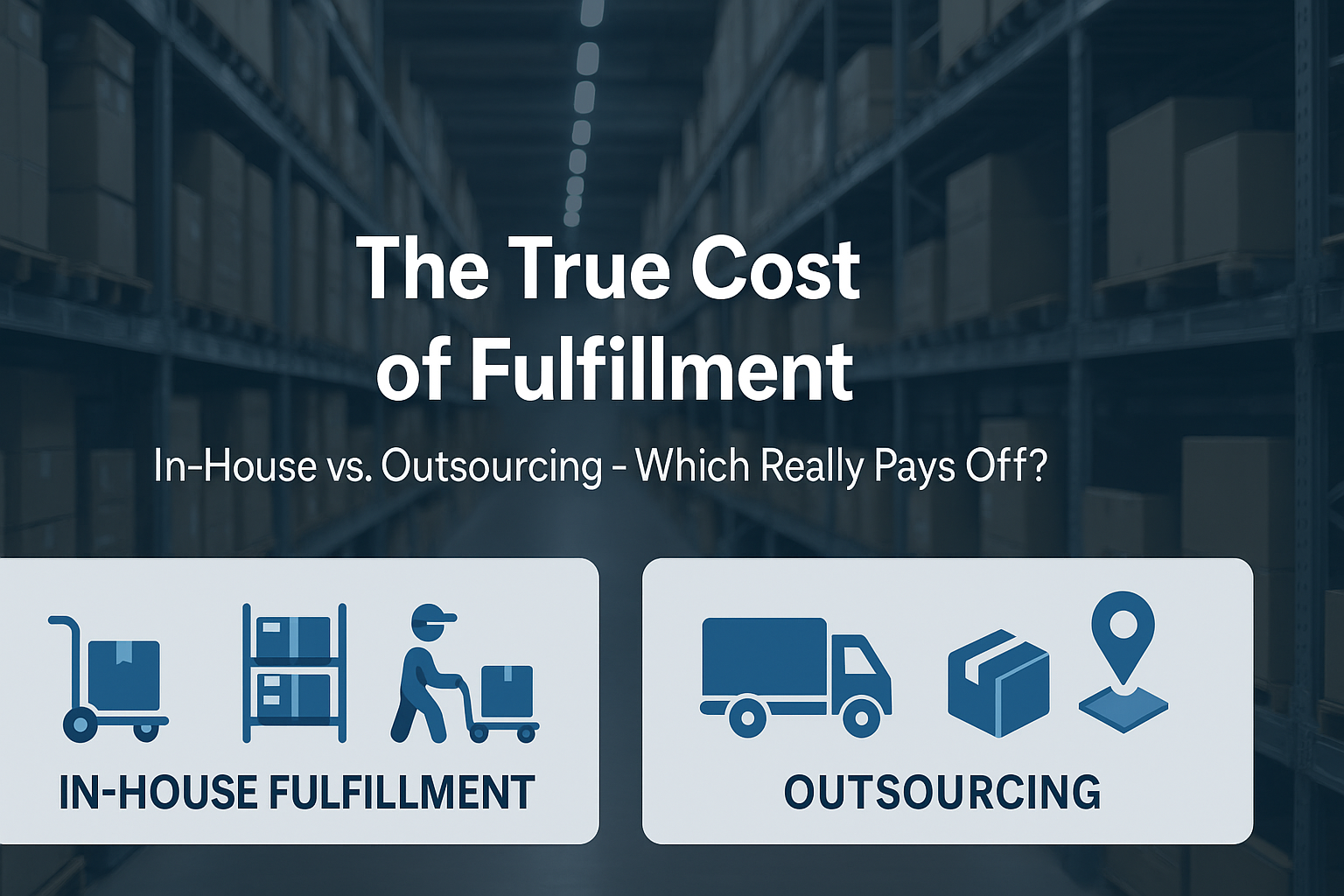In the fast-paced world of e-commerce, the question of how to handle order fulfillment is not just about getting products to customers. It’s a strategic decision that shapes your brand’s growth, customer satisfaction, and, most importantly, your bottom line. Many growing brands start with in-house fulfillment—storing, picking, packing, and shipping orders from their own facilities, a garage, or even a spare room. It seems like the most straightforward and cost-effective option, doesn’t it?
However, as your business scales, the hidden complexities and spiraling costs of in-house fulfillment can quickly turn a once-manageable process into a major obstacle. This detailed breakdown will reveal the true financial and operational burden of managing fulfillment yourself, and provide a clear, data-driven comparison with the benefits of outsourcing to a professional 3PL (Third-Party Logistics) provider like WarehouseTX.
By the end of this analysis, you will understand why leading global brands trust expert partners to handle their logistics, allowing them to focus on what they do best: building their brand and creating great products.
—
The Hidden Costs of In-House Fulfillment: A Reality Check
On the surface, in-house fulfillment appears to offer total control and flexibility. But a closer look reveals a web of expenses that are often overlooked. Let’s break down the major cost centers that define the “true cost” of doing it yourself.
1. Direct Labor and Overhead Costs
This is more than just salaries. It’s the full burden of employment.
- Salaries & Wages: Hiring a team for picking, packing, and shipping. For a small operation, this might be a few part-time employees. For a growing brand, it becomes a full-time, multi-person department.
- Benefits and Taxes: Don’t forget the added costs of health insurance, payroll taxes, workers’ compensation, and retirement contributions, which can add 20-40% on top of base wages.
- Training and Management: The time and resources spent on training new employees and managing a logistics team. This is a non-quantifiable but very real cost to your leadership.
- Seasonal Staffing: The immense challenge of scaling your team for peak seasons like Black Friday or the holiday rush. Hiring and training temporary staff is inefficient and can lead to higher error rates.
2. Facility and Infrastructure Expenses
Your “warehouse” is a significant investment, whether it’s a leased space or a dedicated facility.
- Lease/Rent: Monthly rent for warehouse space, often priced per square foot, can be a major fixed cost.
- Utilities: Electricity for lighting, HVAC, and equipment; water; and internet are all necessary expenses that add up.
- Property Taxes and Insurance: A fixed burden that increases with the value of your property and inventory.
- Maintenance and Security: Regular upkeep, pest control, and security systems to protect your assets and inventory.
3. Technology and Equipment Investments
A manual system is a recipe for inefficiency and errors. Proper fulfillment requires a significant tech stack and specialized equipment.
- Warehouse Management System (WMS): A WMS is essential for real-time inventory tracking, order management, and reporting. Implementing and maintaining one can cost thousands of dollars annually.
- Hardware: Scanners, printers, computers, and POS systems are all necessary tools.
- Material Handling Equipment: Pallet jacks, forklifts, shelving, and conveyor systems require a substantial upfront investment and ongoing maintenance.
- Software Integrations: The cost and complexity of integrating your WMS with your e-commerce platforms (Shopify, BigCommerce, etc.) and shipping carriers (UPS, FedEx, USPS).
4. Shipping and Packaging Costs
While this is a shared cost, the efficiency with which you manage it is a key differentiator.
- Packaging Materials: Boxes, poly mailers, bubble wrap, tape, and branded inserts add up, and you lack the bulk purchasing power of a major 3PL.
- Shipping Rates: Without the volume to negotiate deeply discounted rates, you’ll be paying standard, often higher, prices for shipping.
—
In-House vs. Outsourcing: A Comparative Analysis
To truly understand the value of outsourcing, let’s compare the two models side-by-side using a hypothetical e-commerce brand, “Urban Threads,” a growing apparel company with an average of 5,000 monthly orders.
| Cost Center | In-House Fulfillment (Estimated Monthly Cost) | Outsourced Fulfillment (Estimated Monthly Cost) | Analysis |
|---|---|---|---|
| Labor | $15,000 (3-4 full-time employees) | Included in per-unit pricing | Outsourcing converts a high, fixed labor cost into a variable, pay-as-you-go expense. |
| Facility | $7,000 (2,000 sq. ft. warehouse) | Included in storage fees (~$1,500) | 3PLs offer scalable, shared space, eliminating the need for a dedicated, expensive facility. |
| Technology (WMS, etc.) | $1,000 (Software licenses, maintenance) | Included | 3PLs like WarehouseTX provide state-of-the-art technology at no extra cost to you. |
| Shipping Rates | $4.50 – $12.00 per package (Standard rates) | $3.50 – $9.50 per package (Negotiated rates) | 3PLs leverage their massive shipping volume to secure significant discounts, which they pass on to you. |
| Packaging Materials | $1.50 per order (Retail cost) | $0.75 per order (Wholesale cost via 3PL) | 3PLs have economies of scale for packaging, reducing your per-unit costs. |
| Time & Management Burden | 100+ hours/month (Senior management time) | 5-10 hours/month (Account management) | This is the most critical non-financial cost. Outsourcing frees up your team to focus on growth. |
| Total Estimated Monthly Cost | $50,000+ | $35,000+ | (Note: Costs are estimates and vary. This shows the general relationship between costs.) |
As this table illustrates, while the per-order cost might seem slightly higher with a 3PL on the surface, the elimination of all fixed costs—labor, rent, and technology—makes outsourcing a far more scalable and ultimately more profitable model for most growing e-commerce businesses.
—
Beyond the Numbers: Strategic Advantages of Outsourcing
The decision to outsource isn’t just about cutting costs. It’s a strategic move that unlocks new opportunities for growth and efficiency. Here are some key advantages that a 3PL provides:
1. Nationwide Warehouse & Fulfillment Network
Operating a single warehouse in Houston, Texas, limits your reach and increases shipping times for customers on the East or West Coast. A professional 3PL like WarehouseTX has a nationwide network of fulfillment centers.
Case Study: The “Virginia-Texas-California” Strategy
An e-commerce brand selling consumer electronics was struggling with high shipping costs and slow delivery times to customers on the West Coast. By partnering with a 3PL with fulfillment centers in Virginia, Texas, and California, they were able to:
- Reduce Shipping Zones: Orders are shipped from the closest warehouse, often placing the customer in Zone 2 or 3 instead of Zone 8.
- Improve Delivery Speed: Customers in California receive their orders in 1-2 days instead of 5-7 days.
- Lower Shipping Costs: By shipping to lower zones, they cut their average shipping cost per order by 25%.
- Increase Conversions: Fast, affordable shipping is a major conversion factor. The company saw a 10% increase in their West Coast conversion rate.
2. Expertise and Scalability
Logistics is a complex field. 3PLs are experts in it. They handle everything from managing returns to optimizing picking paths and negotiating with carriers. This expertise is immediately at your disposal, without the need for you to hire a team of seasoned professionals.
Quote-Worthy Insight:
“Outsourcing your fulfillment isn’t about giving up control; it’s about gaining an expert partner. You’re not just paying for a service; you’re leveraging decades of logistics experience to make your supply chain more efficient and resilient.”
3. Seamless Integration with E-commerce Platforms
A modern 3PL’s technology stack integrates directly with all major e-commerce platforms like Shopify, Magento, and WooCommerce. This ensures real-time inventory syncing, automated order processing, and a seamless flow of information from your store to the warehouse.
The value of a 3PL in this context is the “plug-and-play” nature of their services. Instead of building and maintaining complex integrations yourself, you simply connect your store and let their system handle the rest.
—
Final Verdict: The Strategic Choice for Growth
For most e-commerce businesses, the journey from garage-based fulfillment to a professional 3PL is not a matter of “if,” but “when.” The true cost of in-house fulfillment is not just the visible expenses, but the invisible burdens of management time, limited scalability, and missed opportunities. By partnering with a specialist like WarehouseTX, you convert fixed costs into variable costs, gain a competitive edge with faster shipping and lower rates, and free up valuable resources to invest in marketing, product development, and customer acquisition. The decision to outsource is not a cost—it’s an investment in your brand’s future.
—
Frequently Asked Questions About Fulfillment
What is the difference between a fulfillment center and a warehouse?
A warehouse is primarily a storage facility. Its main function is to hold inventory for extended periods. A fulfillment center, on the other hand, is a hub for high-velocity operations. Its purpose is to efficiently process, pick, pack, and ship orders as soon as they are received. While all fulfillment centers are warehouses, not all warehouses are fulfillment centers. Fulfillment centers are optimized for speed and e-commerce logistics.
How do 3PLs save me money on shipping?
3PLs save money on shipping in two primary ways. First, they have massive shipping volume and can negotiate heavily discounted rates with major carriers (like UPS, FedEx, and USPS) that individual businesses cannot. Second, by utilizing their nationwide network of fulfillment centers, they can ship orders from the location closest to the customer, which reduces the shipping zone and, consequently, the cost and transit time.
What types of businesses benefit most from outsourcing fulfillment?
Outsourcing is ideal for e-commerce businesses of all sizes, especially those experiencing rapid growth. It’s particularly beneficial for brands with: high order volume, a wide geographic customer base, limited in-house space, and a desire to focus on core business functions like marketing and product development. Businesses that sell a diverse range of products, or that have complex packaging needs, also see significant benefits from a 3PL’s expertise.
How does a 3PL handle my returns?
A good 3PL provides a complete return management (reverse logistics) solution. When a return is initiated, the 3PL receives the item, inspects its condition, and then processes it based on your pre-defined rules (e.g., restocking, refurbishing, or disposal). This system simplifies the entire process, reduces your costs, and ensures a faster, more professional experience for your customers, which is crucial for building brand loyalty.

